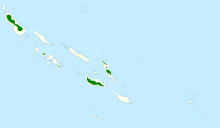| Pale mountain pigeon | |
|---|---|
| Scientific classification | |
| Domain: | Eukaryota |
| Kingdom: | Animalia |
| Phylum: | Chordata |
| Class: | Aves |
| Order: | Columbiformes |
| Family: | Columbidae |
| Genus: | Gymnophaps |
| Species: | G. solomonensis
|
| Binomial name | |
| Gymnophaps solomonensis | |

| |
| Range of the pale mountain pigeon | |
The pale mountain pigeon (Gymnophaps solomonensis) is a species of bird in the pigeon family Columbidae. It is endemic to the Solomon Islands archipelago, where it inhabits old-growth and secondary montane forest. It is a medium-size pigeon with an average length of 38 cm (15 in) and a weight of 310–385 g (10.9–13.6 oz). The head and neck are whitish-grey, the belly and lower breast are buffy-pink, and the vent and undertail coverts are pale grey. The upperparts are smoky-grey with darker fringes on the mantle and wing coverts. Both sexes look similar, but there can be large variation in individual appearance.
The pale mountain pigeon feeds on fruit and forages in large flocks. Breeding occurs from July to September in Bougainville and it prefers stunted moss forest containing Eugenia and Syzygium trees during the breeding season. It nests in shallow depressions or scrapes in the forest floor, and lays single white eggs. It is listed as being of least concern by the International Union for Conservation of Nature (IUCN) on the IUCN Red List due to its stable population and a sufficiently large range.
- ^ BirdLife International (2016). "Gymnophaps solomonensis". IUCN Red List of Threatened Species. 2016: e.T22691860A93326309. doi:10.2305/IUCN.UK.2016-3.RLTS.T22691860A93326309.en. Retrieved 2021-11-12.
- ^ Cite error: The named reference
Mayr 1931was invoked but never defined (see the help page).
